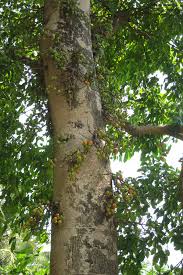Umber (Country fig)
In this article we are going to learn about the plant Umber (Country fig) . Wad, pimpal, fig etc. It is an evergreen tree in the Moraceae family of plants. Its name is ‘Audumbara’ in Sanskrit. Mainly Australia, Sri Lanka, Myanmar, India etc. It is found in countries. The scientific name of this plant is Ficus racemosa or Ficus glomerata.

The height of umber tree is 15-18 m. There is The leaves are dark green, large, alternate and oval or oblong. The bark is gray, smooth and thick. 0.5 to 2 cm of trunk and branch bark thickness according to the age of the tree. may be Also papules of white tissue can be seen separating on the surface of the trunk. Fruits 2 to 5 cm. in diameter and are purple and hanging on big branches with ghos. They are commonly called Umber. Birds eat these fruits, spreading umber seeds through their droppings.
Must Read – Isabagol
There is a misconception that Umbra does not have flowers. Umbra fruit is the flower cluster of that plant. If you cut this fruit, these flowers are visible. It has three types of flowers namely male flowers, female flowers and sterile flowers. The female of the caterpillar-sized insect Blastophaga senes penetrates the underside of the umbel to oviposit and lays her eggs in the impotent flower. Its body contains numerous pollen grains that have been spread from another flower. The hole through which it enters is prevented from exiting by the presence of many stiff, inward-curved spines. While searching for a way out, the pollen on her body irrigates the female flowers in the umbel and she dies inside. Over time, the male flowers in the umbar bloom. Around this time, the chicks emerge from the insect’s eggs and grow. Their males and females mate and the male dies. Fertilized females are looking for a way out. At this time, pollen from the male flower is spread on their body. As the gills near the upper opening of the umbra become soft, the females can easily exit and move to another raw umbra to lay their eggs. Thus the cycle continues. Blastophaga senes is an insect and umber cannot live without each other. Their symbiosis achieves both the objectives of insect reproduction and plant pollination. This is a prime example of the interdependence of different types of organisms in nature.

All parts of the umber tree are medicinal. Bark is astringent and used in animal diseases. The root is useful in dysentery and its juice is useful in diabetes. The fruit is an appetite stimulant and is beneficial for menstrual hyperflow. Chik is effective against hemorrhoids and diarrhea.
Like to Read – Amarvel/Dodder
The wood of umber is whitish or reddish, soft and light. Many common items, house construction, agricultural use items etc. This wood is used for making. The bark is used to make a fine black dye. All the parts of this tree emit bark and glue is made from it to catch birds.
Benefits of Umber (Country fig)
Unripe umbers are green in color and turn red and pink when ripe. Fruits are produced between March and June. These fruits are sweet in taste. In Ayurveda, umbar bark, leaves, roots and the milky white sap that comes out of it are all used for treatment. Umbar fruit removes kapha and pitta dosha from the body. Various parts of this tree are used as an anti-inflammatory and pain reliever. Applying its bark on burnt skin reduces inflammation. The white liquid of umber also stops blood, frequent defecation, urine from the body. Consumption of fruits increases sperm and strength of man. Also the mind is always happy. If its juice is applied on the pimples, they will ripen and heal. The juice of its roots reduces inflammation in the body.
1) If there is bleeding from the nose, drink the juice of ripe Umber (Country fig) fruit with jaggery or honey in it. The same remedy should be taken even if there is heavy bleeding during menstruation.
2) Drink ripe umbar juice with sugar in it if you have heat or fire-producing disorders.

3) In case of diabetes, drinking the juice of young leaves of Umbra with honey 2 times every day does not require frequent urination.
4) For tongue sores, scars, bleeding from gums, toothache, tooth movement, make a decoction of this bark or leaves and keep it in the mouth and fill the hearth.
5) Another good use of umbar is to apply the white juice of umbar to reduce the pain caused by cracks in the skin of the hands and feet. If there is redness of the eyes, watery eyes, irritation of the eyes, extract the leaves of umber and strain it with a clean cloth and after cooling, put 2 drops of it in the eyes 4 times a day.
Read Also – Uses of Ginger
6) If children have loose stools, add sugar to umber juice and give it to drink. In case of contamination of blood and bile in the body and inflammation of the body, the extract of Umbra bark should be taken in the stomach. Consuming this extract is beneficial even if there is constant thirst. Also, if there is bleeding from the nose, mouth and anus, this extract is beneficial.
7. If bleeding occurs, take 10 drops of umbar tea with milk.
8. Rubbing umbar on mumps, goitre, pus-filled wounds and stubborn swelling reduces pain and swelling quickly.
9. Small blisters appear on the leaves of Umbra. Dispersing those blisters in milk gives quick relief in measles.
10. Liver enlargement is caused by drinking or smoking. There is also a fear of dropsy. In such cases, eating umbar fruits boiled in goat’s milk gives relief.
11. For burns, sores on the heels, bleeding disorders, split the fruits of Umbra and apply it and keep it tied with a clean bandage overnight.
12. Take the powder of umbar bark with milk in malaria or winter fever. The bark should never be removed, as heat destroys its fiery qualities.
Amber tree is a multi-purpose tree but before doing the above remedies, consult an expert. It is important to have proper guidance or information while doing any remedy.
Source : Prime Maharashtra
Read More –
Faq –
1 What is the scientific name of umber ?
2 Does umbra have a flower ?
3 What are the benefits of Umbra ?